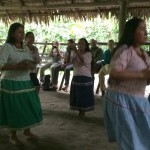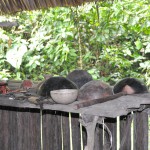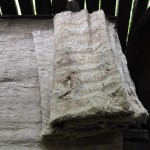This is a three part series on the Kichwa people living near the Yasuni National Park in the eastern Ecuadorian Amazon Basin along the Napo River. In Part 1 of the series, we discuss the village, schools, and infrastructure. In Part 2 of the series, we visit a Kichwa farm. In Part 3 of the series, we visit a cultural center and see how the Kichwa women are working to preserve their culture.
Part 3 – The Cultural Center
During our recent trip to the Amazon, we have several opportunities to visit with the local indigenous population. We were able to visit a Kichwa community, a Kichwa farm, and a Kichwa cultural area.
The Kichwa (or Quechua) are an indigenous people in South America. They speak the Kichwa language, which is also the same language the Inca’s spoke. They are found primarily in Ecuador, Peru, Bolivia, Chile, Colombia, and Argentina. Total population of Kichwa people is between 10 and 11 million people, with about 2.5 million of them in Ecuador.
In Part 1 of the series, we looked at a village commune and visited a school.
In Part 2 of the series, we looked at a farm.
Our third visit was to an Añangu Kichwa Cultural Center.The cultural center was built by and is staffed by women of the Añangu Kichwa Community. It’s their contribution to keep their society and culture intact as the modern world encroaches in upon them. They use the center to show visitors their ways and to earn extra money for their families and communities.
The center is divided into 4 areas; the Clay Lick, the Heritage Center, the Traditional House, and the Store.
The Clay Lick
The Clay Lick is an exposed area on the side of a hill. The land has given way in a landslide, and removed some brush and trees, exposing the clay soil. This is an important element in the Amazon as parrots and parakeets require clay in their diets. Whenever an area becomes exposed, these birds flock to the area in a ritualistic fashion. Every day between 10am and 11am, thousands of parrots descend upon the exposed clay to eat it. The cacophony of noise they make is unbelievable. The most prominent parrot seen is the typical Green Amazon Parrot, but Blue Headed Parrots are seen frequently as well as the Parakeets. A large wooden “blind” was constructed to allow people to witness this spectacle without disturbing the birds.
The Heritage Center Pavilion
After witnessing the parrots at the Clay Lick, we worked our way down a wooden boardwalk to a large open pavilion. The structure had a large thatched roof and a row of benches down two opposing sides. We sat on one of the benches with the other visitors. One of the Kichwa women walked to the center of the pavilion and started explaining a little about their culture and the program, etc. She spoke to us in Kichwa, with a guide from another group translating everything into English.
A group of women then proceeded to play a drum (a hollowed log with monkey skin stretched over both ends), and a turtle shell (makes a deeps sound when rubbed with the hand) and to sing traditional songs, while others danced traditional dances. At one point the women came and invited visitors, such as myself, to dance with them.
Traditional House
After the music and dancing, we left the pavilion and went to a replica of a traditional Kichwa house. It was a round structure, with walls about 3 feet high. Then an open space above that, and then a thatched roof starting at about 7 feet up. The thatched roof was made from logs, poles, and palm leaves all tied together with strips of bark. The construction appears to be quite sturdy.
In the center of the house was a rack with a few shelves. This was the kitchen. On the floor was a small fire, surrounded by stones. On the fire sat ceramic pot for cooking. A fresh banana leaf was used as a lid. Nearby were several other pots of varying sizes. It was very difficult to start a fire, therefore they kept it going 24 hours a day.
On the first shelf, about 3 feet above the fire, was stored cooking utensils, and some fresh roots, some fresh meat and a small basket. The smoke and heat from the fire below would serve many purposes. It would dry and smoke the meat, roots or vegetables slowly. It would keep the baskets and utensils dry, preventing mold or bacteria buildup. It would also keep the insects away.
The second shelf was above the first. Upon this shelf were stored larger baskets, such as those for carrying the manioc. Also spears, fishing tools, and other items were to be found lying or hanging here. By keeping these things above the fire, the smoke would keep the baskets and tools dry and prevent them from rotting or decaying, and allow them to be used a very long time.
To the side of the kitchen were larger clay pots and a table. The table contained several items used for cooking. Bowls of various sizes, spoons, and stirring sticks. The clay pots were more or less the “pantry”. Dried foods or chicha, the alcoholic drink made from manioc, would be stored here. Dried animal skins would be used as a lid to keep insects away. At this time, a bowl of chicha was passed around for everyone to sample. It was bitter, but I neither liked it nor disliked it.
We were given a full demonstration of how all the things in the kitchen were used. From making soup, tending the fire, to mashing the manioc, all the things were explained in very good detail by the Kichwa woman. She explained everything in a nice very easy to understand Spanish, which would then be translated by a Napo guide into English for us. As I speak Spanish, I thought it very amusing when every time he would translate, he would exaggerate what she had said in Spanish. For example, she said, in Spanish, “the women would take the large basket and carry it 200 yards into the forest and harvest manioc. When the basket was full, they would haul the 40-50 pounds of manioc back to the house.” When translated by the guide to English, he said “the women would take the large basket and carry it 500 yards into the forest and harvest manioc. When the basket was full, they would haul the 80-85 pounds of manioc back to the house.” Since I was probably the only visitor present who could speak Spanish, I found this very amusing.
Along one wall we came to the bed. It was basically a wide table to let them sleep off the ground. The most interesting thing was the linens. The blankets were made from tree bark. They would carefully cut and unwrap the bark from a tree. Then they would soak it, mash it, chew it and then dry it until it was soft like cloth. Simply amazing.
After the demonstration was over, we were allowed to investigate the house fully. We could touch, handle, and study all the various items on display. I really liked the spear.
I’ve included the full unedited video of the demonstration. It’s a rather long video, almost an hour, and includes the original Spanish and English. Maybe someday I’ll edit it down to a more reasonable length. But for those inclined, here it is.
The Store
The fourth and final part of the cultural center was the store. It was a small shop selling crafts and handmade local items. There was jewelry, pottery, art, paintings, and many other items. All items were handmade by local people and were sold to help support the center. We bought a hollowed out wooden log to use as a pencil holder.
All in all it was a very interesting day. I’m glad we could participate in this eco-tourism, and contribute in our small way to keeping it going for future generations. We learned many things and came away with an appreciation for these people, who have learned to balance life in the modern world with their ancient traditions.
Part 1 – The Village Commune
Part 2 – The Farm
Part 3 – Cultural Center




















